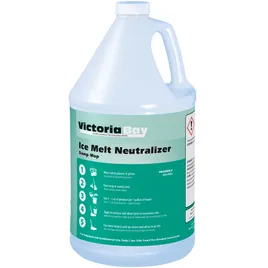During the winter months, ice melt and salts are used to keep sidewalks and entryways from getting slippery, helping to protect the safety of building occupants.
While protecting people from injury, ice melt creates a range of cleaning challenges inside the building.
Although ice melt is applied outside in parking lots, on sidewalks, and near entryways, the particles can become stuck to people’s shoes and be brought inside as they enter the building.
The problem is, when ice melt residue gets tracked onto entryway matting, carpet, or other soft surfaces, it can leave unsightly white crusty stains. Additionally, ice melt is very alkaline, and when left on carpets, it attracts dirt and soils, leaving your carpets dirty and stained.
Ice melt, in its most common form, is solid pellets. The particles are hard and extremely abrasive. The hard pellets can not only leave behind residues but can also damage these soft surfaces. As people walk, the small pellets can be ground into carpet and matting by the foot traffic, cutting and dulling fibers.
It is imperative to the appearance and longevity of your carpet, that ice melt and salt residues are removed.
However, most ice melt compounds contain salt, calcium, and other compounds that can be difficult to remove. 
If rinsed with the wrong cleaning chemical, ice melt and salt can cause permanent stains or discoloration.
The safest and best way to remove white stains on commercial carpets caused by salt or ice melt residue is rinsing with a floor neutralizer and cleaning using a carpet extractor.
In this article and video, we’ll review the 6 steps to remove stubborn salt and ice melt residue from your carpets.
Step 1: Vacuum Carpet

Start the cleaning procedure by vacuuming the area to be treated.
There are likely soils and solid ice melt particles trapped in the carpet that should be removed before a neutralizer is applied. This requires increased and more thorough vacuuming to remove any solid ice melt compounds.
Failing to remove as many contaminants as possible increases the likelihood that when the floor neutralizer is applied it will create other issues, such as additional carpet spots or recurring stains.
Be mindful not to vacuum the area if it is wet or damp. Industrial vacuums are very powerful and can suck moisture and liquids from the carpet, however, they are not built to handle liquids.
Liquids can damage the vacuum motor, causing unnecessary equipment downtime and lost productivity.
In most cases, you can use a wet/dry vac to remove wet soils.
Step 2: Apply Floor Neutralizer

After vacuuming, use a pump-up sprayer or trigger sprayer, according to the chemical manufacturer’s dilution instructions, to apply the floor neutralizer directly to the carpet.
Do not add the floor neutralizer to your commercial carpet extractor. The extractor should only hold water and extractor rinse.
A neutralizing chemical is essential to removing ice melt residue and white stains on carpet. Do not use high pH cleaning chemicals. High pH cleaning chemicals will not be effective at removing the residues. They can also be damaging to the carpet.
Floor neutralizers are specifically designed to dissolve ice melt chlorides, soap, and hard water films as well as scum, scale, and other mineral residues.
Step 3: Let Dwell
Let the neutralizer sit on the carpet for the recommended dwell time.
Dwell time will vary by manufacturer but is typically around 10 minutes.
Pro Tip: What is Dwell Time? Dwell time is the amount of time the product needs to remain wet on a surface to perform effectively.
Step 4: Work Neutralizer Into The Carpet
Use a spotting brush to work the cleaner into the carpet. The agitation will help loosen the residue and make it easier to remove.
If the area is too large use a floor machine equipped with a carpet brush to agitate the cleaner.
Step 5: Blot or Extract The Stain
Depending on the size of the area you are dealing with, blot the stain with a colorfast towel or use a carpet extractor to remove any remaining soils. 
Thoroughly remove as much water and chemical as possible to reduce the likelihood of recurring stains.
Pro Tip: Recurring stains are the result of wicking. Wicking is the result of an improperly cleaned stain. As the carpet begins to dry, wetted soil that was not fully removed from the carpet backing is drawn up to the top of the carpet fibers. This “wicking” action causes recurring or reappearing stains.
Step 6: Let Dry
 Make sure the carpet is completely dry before replacing furniture or walking on the surface.
Make sure the carpet is completely dry before replacing furniture or walking on the surface.
If you do not let the carpet dry completely, it will attract dirt and become a breeding ground for mold and bacteria.
Pro Tip: You can use an air mover/blower to shorten drying times.
Final Thoughts
Salt and ice residue on carpets are unsightly and often very stubborn. Attempting to remove these residues without the right supplies and equipment will likely be difficult. It can even result in damaged carpeting.
While carpet spots and discoloration from ice melt is not 100% preventable, they can be removed.
Applying a floor neutralizer will help break down the ice melt compounds and remove the stain. You can then clean the carpet with either a carpet extractor.
Imperial Dade locations have the right janitorial floor cleaning products and equipment to keep your facility’s carpets looking their best during the winter.
If you’re located in the United States or Canada, contact a specialist today for help choosing the right products and equipment for your floor care program.
